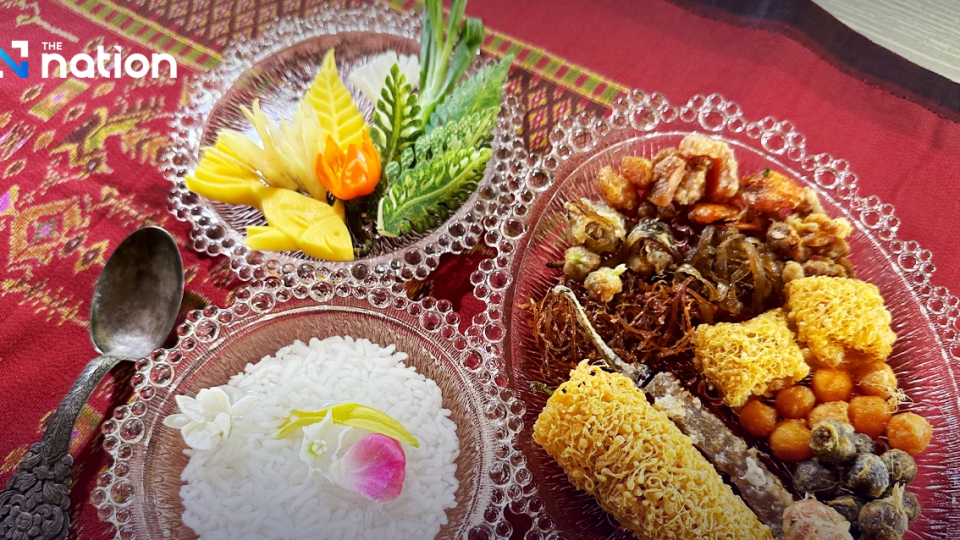April 24, 2024
BANGKOK – During the reign of King Rama IV (1851-1868), chefs at the royal court created a dish with a cooling effect on the body. Called Khao Chae and consisting of cooked rice cooled in flower-scented water served with various condiments, it remains the go-to meal for the summer months even though it can be hard to find.
The Nation chatted with Jantararat Hemvej, an interior designer passionate about Thai traditional cuisine. She pursued that passion by gathering traditional and rare recipes, studying old books and digging into the memories of those who once lived in the palace as well as her own ancestors.
She went on to teach several Thai celebrity chefs some of the royal dishes that made up the royal menu, opening a studio named Studio Chan to host workshops and educate others about these obscure Thai dishes.
Jantararat said that Khao Chae dates back to the reign of King Rama IV, when his main concubine, Chao Chom Manda Klin made a special offering to the monarch and it became the king’s favourite.
Of Mon descent, Chao Chom Manda Klin adapted Khao Chae from Mon cuisine. It was originally served in the Phra Nakhon Khiri Palace in Phetchaburi, the summer palace of King Rama IV, but became popular outside of the royal residence as a hot season dish in the early 1900s.
A set of Khao Chae’s condiments includes small shrimp paste balls simmered with herbs (Lookkapi), sweet radish, sweet shredded beef or pork, crispy fish, stuffed green chillies wrapped in an omelette net and lastly a set of greens including green mango, spring onion, cucumber and finger root.
The combination of cooked rice in perfumed, chilled water, sweet and salty condiments and the sourness of green mango, is a perfect blend that makes this refreshing dish a favourite on a hot day.
“Enjoying a serving of Khao Chae is also an art in itself,” Jantararat added. The rice and the condiments need to be eaten separately, with one bite of a condiment followed by a small bite of rice soaked in floral-scented water. If eaten together, the floral-scented water will lose its freshness.
The ingredients used to make Khao Chae have changed throughout time. For example, five to seven condiments are the norm, fewer than in the past.
“At Studio Chan, we have 19 different kinds of condiments,” she said. Lookkapi, or shrimp paste balls cooked with herbs, serves as the foundation for these distinct condiments that Jantararat has created.
“That demonstrates how we work to come up with new and exciting ways to enjoy khao chae,” said Jantararat.
According to Jantararat, simpler floral-scented water is made just of jasmine rather than four other kinds of flowers: jasmine, ylang-ylang, bread flower (Chommanat), and rose petals.
“You can only find this once-a-year treat during Thai summer, and there is no better time to enjoy it,” she says, adding that Thais are in the habit of consuming seasonal food.
“Thais don’t eat anything that is out of the season since they might not be at their best and can be costly.”
Consuming food as medicine
Traditionally, Thai people have consumed food as if they were taking medicines. For example, when the weather is hot, they will make dishes that contain herbs and vegetables like cucumber, pandan leaf, and green squash, which have a cooling effect on the body. They drink chrysanthemum tea and Centella asiatica juice.
Thais also avoid eating food which is spicy, too sweet, too salty and too oily. These foods will stimulate heat or inflammation in the body, while mild and bitter foods are recommended to cool down the body temperature and get rid of accumulated hot toxins in the body.
On the other hand, when the winter comes, Thais eat something hot to balance their body temperature like garlic, basil, chives, ginger, galangal, turmeric, coriander and chilli.
Surprisingly, all this traditional Thai knowledge helping Thai people avoid illness in the past correlates with standard medical practice. This is evidenced by Thai Health Promotion Foundation’s initiative that encourages more people to eat food as medication to prevent certain diseases.
Passing on Thai traditional culture
Jantararat said that not only is Khao Chae more difficult to find these days but there are also many Thai traditional recipes that are unknown to modern people.
She hopes to overcome this by turning Studio Chan into a venue where people can sample traditional dishes and take part in workshops designed to educate and pass on the knowledge she learned from the old recipes.
Jantararat also teaches youngsters who are interested in making Thai traditional dishes in her spare time.
Vasispol Thonguthaisri, one of Jantararat’s students who just graduated from the Fisheries faculty at Kasetsart University, discovered a passion for Thai cuisine and said that he hopes to advance this knowledge in his future career by adding new faces to the pool of Thai cuisine professionals and preserve this invaluable expertise for the coming generation.


